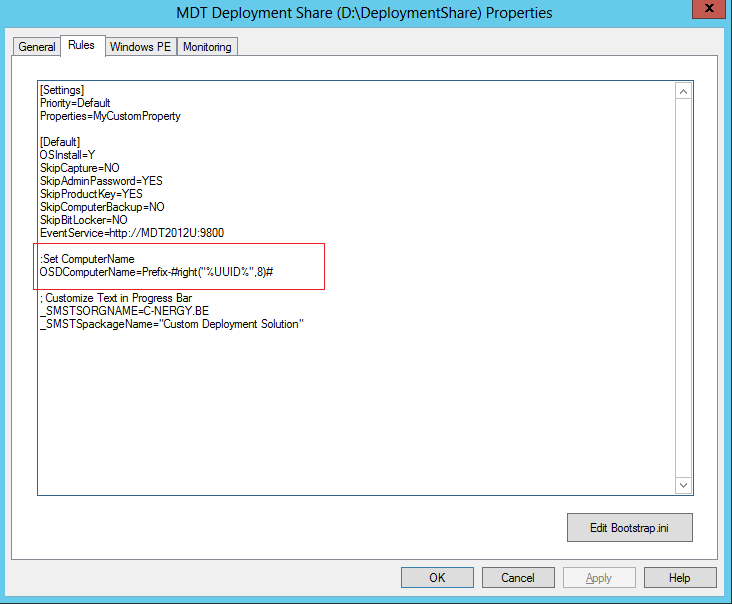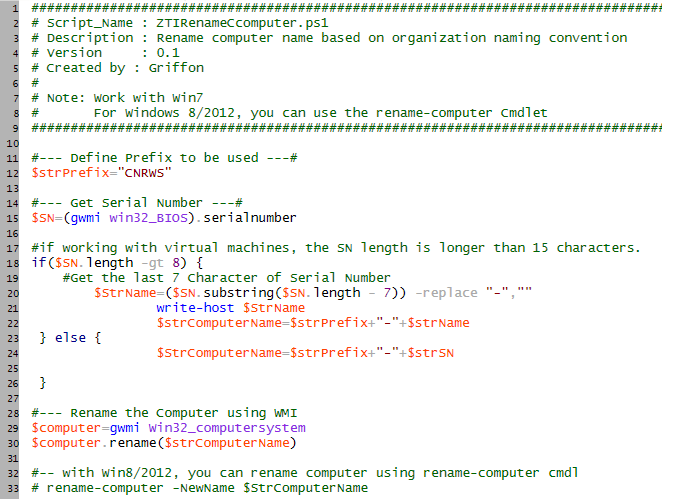Mdt Osdcomputername Serial Number
Mdt Osdcomputername Serial Number' title='Mdt Osdcomputername Serial Number' />Windows 10 Thread, Sysprep Win 10 Prompt for Computer Name in Technical I have been testing Windows 10 and struggling to, once captured the image to get the propmt. Forums/getfile/527270' alt='Mdt Osdcomputername Serial Number' title='Mdt Osdcomputername Serial Number' />
 SCCM and MDT offer a great deal of variables, but the documentation of them is sometime not so friendly. I have created some tables below of the variables, which are. February 26, 2017 at 1545. I think it is because the name of your TS contains a. OSDComputerNameW10ENUS. O2016EN, therefore it is not a string, I can. The previous article in our Microsoft Deployment Toolkit MDT series explained how to use Bootstrap. I dont understand the CustomSettings. I hear this from a high percentage of clients who use MDT in their environment. If they started with an MDTonly. MDT 2012 Settings for fully automated LTI deployment, Part I Bootstrap. Mvd at 1610. Hi, nice blog One question about. Hi Usman, Make sure that youre not setting the OSDComputerName variable in your CustomSettings. Automate Computer Name during OSD in Config. Mgr 2. 01. 2 with Power. Shell System Center Config. Mgr. There are various of methods out there today on how you can automate the process of naming computers during OSD. Ive previously blogged about how to do it with VB script, you can find that blog here. In this blog post well be renaming the computer based upon two critera. First we need to determine what computer model the OS is being deployed on. Secondly we want to name the computer by using the serial number and a suffix, e. In this blog post Im performing OSD on Dell systems, but the script can easily be modified to support other vendors. The script. We begin with populating two variables, Computer. Model and Serial. Number data from WMI. Then we create two if conditions depending on the computer model in this case laptop or workstation. In each if condition we combine Serial. Number with a dash and at the end a suffix for either a workstation or laptop. Well then get something like 1. WS or 1. 23. 45. 67 LAP in the OSDComputer. Name variable. Next we create a new COM object from the Microsoft. SMS. TSEnvironment class. The value of OSDComputer. Name will then be put into the newly created COM object. Computer. Model Get Wmi. Object Class Win. Computer. System Select Object Model. Model. Serial. Number Get Wmi. Object Class Win. BIOS Select Object Serial. Number. Serial. Number. Computer. Model match Precision OR Computer. Model match Optiplex. OSDComputer. Name Serial. Number WS. TSEnv New Object COMObject Microsoft. SMS. TSEnvironment. TSEnv. ValueOSDComputer. Name OSDComputer. Name. if Computer. Model match Latitude. OSDComputer. Name Serial. Number LAP. TSEnv New Object COMObject Microsoft. SMS. TSEnvironment. TSEnv. ValueOSDComputer. Name OSDComputer. Name. Create a Package with the script. Save the above script to a. OSDComputer. Name. Go to Software Library, Packages and create a new package. Give the Package a name, e. OSDComputer. Name. Check This package contains source files and enter the location where you saved the script. Remember that it has to be an UNC path. Click Next. 4. Choose Do not create a program and click Next. Click Next to confirm the settings. Click Close when the wizard is complete. Distribute the Package to your DPs. Using the script in a Task Sequence. Edit your OSD Task Sequence and add a New group after the Apply Drivers step. Its important that you add the new group before the Apply Windows Settings and Apply Windows Network Settings steps. Name the new group like OSDComputer. Name. 3. In the new group, create a new Run Command Line step and call it Set Power. Shell Execution Policy. Enter the following in the Command line field powershell. Set Execution. Policy Bypass Local. Machine force. In the new group, create a new Run Command Line step and call it OSDComputer. Name. ps. 1. Enter the following in the Command line field powershell. OSDComputer. Name. Check Package and select your newly create package OSDComputer. Name. Picture below says OSDChange. Name, taken from an old package. In the new group, create a new Run Command Line step and call it Revert Power. Shell Execution Policy. Enter the following in the Command line field powershell. Set Execution. Policy Remote. Signed Local. Machine force. You should now have a new group with three steps. Make sure theyre arranged like below. Thats all Run your Task Sequence on a lab client and check out the results. Bsr 2012 Sri Lanka Pdf. Principal Consultant and Enterprise Mobility MVP since 2. Nickolaj has been in the IT industry for the past 1. Enterprise Mobility and Security, Windows devices and deployments including automation. Currently working for True. Sec as a Principal Consultant. Awarded as Power. Shell Hero in 2. 01. Creator of Config. Mgr Prerequisites Tool, Config. Mgr OSD Front. End, Config. Mgr Web. Service to name a few. Frequent speaker at conferences and user groups.
SCCM and MDT offer a great deal of variables, but the documentation of them is sometime not so friendly. I have created some tables below of the variables, which are. February 26, 2017 at 1545. I think it is because the name of your TS contains a. OSDComputerNameW10ENUS. O2016EN, therefore it is not a string, I can. The previous article in our Microsoft Deployment Toolkit MDT series explained how to use Bootstrap. I dont understand the CustomSettings. I hear this from a high percentage of clients who use MDT in their environment. If they started with an MDTonly. MDT 2012 Settings for fully automated LTI deployment, Part I Bootstrap. Mvd at 1610. Hi, nice blog One question about. Hi Usman, Make sure that youre not setting the OSDComputerName variable in your CustomSettings. Automate Computer Name during OSD in Config. Mgr 2. 01. 2 with Power. Shell System Center Config. Mgr. There are various of methods out there today on how you can automate the process of naming computers during OSD. Ive previously blogged about how to do it with VB script, you can find that blog here. In this blog post well be renaming the computer based upon two critera. First we need to determine what computer model the OS is being deployed on. Secondly we want to name the computer by using the serial number and a suffix, e. In this blog post Im performing OSD on Dell systems, but the script can easily be modified to support other vendors. The script. We begin with populating two variables, Computer. Model and Serial. Number data from WMI. Then we create two if conditions depending on the computer model in this case laptop or workstation. In each if condition we combine Serial. Number with a dash and at the end a suffix for either a workstation or laptop. Well then get something like 1. WS or 1. 23. 45. 67 LAP in the OSDComputer. Name variable. Next we create a new COM object from the Microsoft. SMS. TSEnvironment class. The value of OSDComputer. Name will then be put into the newly created COM object. Computer. Model Get Wmi. Object Class Win. Computer. System Select Object Model. Model. Serial. Number Get Wmi. Object Class Win. BIOS Select Object Serial. Number. Serial. Number. Computer. Model match Precision OR Computer. Model match Optiplex. OSDComputer. Name Serial. Number WS. TSEnv New Object COMObject Microsoft. SMS. TSEnvironment. TSEnv. ValueOSDComputer. Name OSDComputer. Name. if Computer. Model match Latitude. OSDComputer. Name Serial. Number LAP. TSEnv New Object COMObject Microsoft. SMS. TSEnvironment. TSEnv. ValueOSDComputer. Name OSDComputer. Name. Create a Package with the script. Save the above script to a. OSDComputer. Name. Go to Software Library, Packages and create a new package. Give the Package a name, e. OSDComputer. Name. Check This package contains source files and enter the location where you saved the script. Remember that it has to be an UNC path. Click Next. 4. Choose Do not create a program and click Next. Click Next to confirm the settings. Click Close when the wizard is complete. Distribute the Package to your DPs. Using the script in a Task Sequence. Edit your OSD Task Sequence and add a New group after the Apply Drivers step. Its important that you add the new group before the Apply Windows Settings and Apply Windows Network Settings steps. Name the new group like OSDComputer. Name. 3. In the new group, create a new Run Command Line step and call it Set Power. Shell Execution Policy. Enter the following in the Command line field powershell. Set Execution. Policy Bypass Local. Machine force. In the new group, create a new Run Command Line step and call it OSDComputer. Name. ps. 1. Enter the following in the Command line field powershell. OSDComputer. Name. Check Package and select your newly create package OSDComputer. Name. Picture below says OSDChange. Name, taken from an old package. In the new group, create a new Run Command Line step and call it Revert Power. Shell Execution Policy. Enter the following in the Command line field powershell. Set Execution. Policy Remote. Signed Local. Machine force. You should now have a new group with three steps. Make sure theyre arranged like below. Thats all Run your Task Sequence on a lab client and check out the results. Bsr 2012 Sri Lanka Pdf. Principal Consultant and Enterprise Mobility MVP since 2. Nickolaj has been in the IT industry for the past 1. Enterprise Mobility and Security, Windows devices and deployments including automation. Currently working for True. Sec as a Principal Consultant. Awarded as Power. Shell Hero in 2. 01. Creator of Config. Mgr Prerequisites Tool, Config. Mgr OSD Front. End, Config. Mgr Web. Service to name a few. Frequent speaker at conferences and user groups.